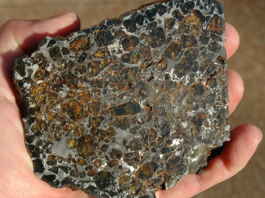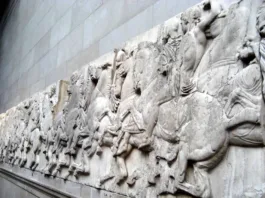Oceanic trenches are long, narrow depressions or deep valleys that occur in the Earth’s oceanic crust. They are the deepest parts of the world’s oceans and are typically located in the areas where tectonic plates meet. Oceanic trenches are formed by the process of plate tectonics, which involves the movement and interaction of the Earth’s lithosphere, the rigid outer layer of the Earth’s surface, consisting of the crust and part of the upper mantle.
Oceanic trenches are characterized by their steep sides and extremely deep depths, often reaching over 10,000 meters (32,800 feet) below sea level. The Challenger Deep, located in the Mariana Trench in the western Pacific Ocean, is the deepest known point in the world’s oceans, with a depth of about 10,924 meters (35,840 feet). Other well-known oceanic trenches include the Peru-Chile Trench in the southeastern Pacific Ocean, the Tonga Trench in the southwestern Pacific Ocean, and the Kermadec Trench in the southwestern Pacific Ocean.
Oceanic trenches are formed by the process of subduction, where one tectonic plate is forced beneath another plate, usually an oceanic plate being pushed beneath a continental plate or another oceanic plate. This process is caused by the movement of tectonic plates, as they are constantly shifting and interacting with each other. The friction and pressure created by the movement of these plates can cause the leading edge of the subducting plate to be pushed down into the mantle, creating a trench-like depression on the ocean floor.
Oceanic trenches are important geological features as they play a crucial role in the recycling of the Earth’s crust. As the oceanic plate is forced into the mantle and subjected to intense heat and pressure, it melts and forms magma. This magma can then rise back up to the surface through volcanic activity, forming new crust and contributing to the formation of new oceanic plates. Additionally, oceanic trenches are often associated with seismic activity, including earthquakes and tsunamis, due to the intense geological forces at work in these areas.

Contents
Importance of oceanic trenches in geology and marine biology
Oceanic trenches are of significant importance in both geology and marine biology due to their unique geological and ecological characteristics. Here are some key aspects:
- Geological Importance: Oceanic trenches provide valuable insights into the Earth’s geological processes. They are formed by subduction, a fundamental process in plate tectonics, where one tectonic plate is forced beneath another. The study of oceanic trenches helps scientists understand the dynamics of tectonic plate movements, including the processes of subduction, faulting, and seismic activity. These trenches also offer a window into the composition and structure of the Earth’s mantle, as the subducting plate is subjected to high pressure and temperature, causing chemical and physical changes in the rocks.
- Marine Biodiversity: Oceanic trenches are unique and extreme environments that support a diverse array of marine life. Despite the extreme depth, high pressure, and low light conditions, trenches are home to various specialized and often endemic species, which are specially adapted to survive in these challenging conditions. Some examples of unique species found in oceanic trenches include deep-sea fishes like anglerfish, snailfish, and cusk eels, as well as deep-sea invertebrates like amphipods, isopods, and polychaete worms. Studying the biodiversity of these trenches can provide insights into the adaptation strategies of marine organisms to extreme environments and their ecological roles.
- Ecological Processes: Oceanic trenches play a crucial role in the global carbon cycle and nutrient cycling. The high primary productivity in surface waters above trenches leads to the production of organic matter that sinks to the deep-sea floor, providing a source of food for deep-sea organisms. The trenches also act as “biological traps,” where organic material from the surface is transported to the deep-sea and sequestered, which has implications for global carbon cycling and climate regulation. The unique physical and chemical conditions of trenches, such as high pressure, low temperature, and high nutrient availability, create specific habitats that influence ecological processes, such as nutrient cycling, carbon sequestration, and biogeochemical cycling.
- Evolutionary Studies: Oceanic trenches can serve as natural laboratories for studying the evolution of marine species. The isolation and unique environmental conditions of trenches can lead to the evolution of distinct populations and species with specialized adaptations. Studying the genetic and evolutionary characteristics of organisms in oceanic trenches can provide insights into the processes of speciation, adaptation, and evolutionary dynamics in extreme environments.
- Resource Potential: Oceanic trenches may also have potential for the discovery of new resources, such as minerals and hydrocarbons. The unique geological processes and conditions in trenches may result in the accumulation of valuable resources, and ongoing research and exploration are being conducted to assess their resource potential.
In conclusion, oceanic trenches are important in geology and marine biology due to their significance in understanding Earth’s geological processes, supporting unique marine biodiversity, influencing ecological processes, providing insights into evolutionary studies, and potential resource exploration. Continued research and exploration of these extreme environments are critical for advancing our understanding of the Earth’s geology, biodiversity, and ecological processes, and their role in shaping the planet’s history and future.

Formation of oceanic trenches
Oceanic trenches are formed through a geological process called subduction, which occurs at the convergent boundaries of tectonic plates. The process of subduction involves one tectonic plate being forced beneath another plate, usually an oceanic plate being pushed beneath either a continental plate or another oceanic plate. Here’s a step-by-step overview of the formation of oceanic trenches:
- Convergent Plate Boundary: Oceanic trenches typically form at convergent plate boundaries, where two tectonic plates are moving towards each other. There are three types of convergent plate boundaries: oceanic-continental, oceanic-oceanic, and continental-continental.
- Subduction: When an oceanic plate encounters either a continental plate or another oceanic plate at a convergent boundary, it is usually denser and sinks beneath the less dense plate in a process called subduction. The denser oceanic plate is forced to dive beneath the less dense plate due to gravity and the intense pressure exerted by the overlying plate.
- Trench Formation: As the oceanic plate is subducted, it descends into the asthenosphere, the partially molten layer of the Earth’s upper mantle. The leading edge of the subducting plate is bent and deformed, creating a trench-like depression on the ocean floor. Over time, as the subduction continues, the trench deepens due to the accumulation of sediment and the bending and fracturing of the Earth’s crust.
- Volcanic Activity: The subduction of the oceanic plate generates intense heat and pressure, causing the mantle to partially melt and form magma. This magma is less dense than the surrounding rock and rises towards the Earth’s surface, leading to volcanic activity. Volcanoes may form on the overriding plate or within the trench itself, creating a volcanic arc parallel to the trench.
- Earthquakes and Tsunamis: The intense geological forces at work during subduction can also result in seismic activity, including earthquakes and tsunamis. As the subducting plate is forced deeper into the mantle, it can become stuck and accumulate stress, which is then released in the form of earthquakes. Tsunamis can also be generated by large earthquakes associated with subduction zones, as the sudden vertical movement of the seafloor can displace a large volume of water.
- Ongoing Geological Process: The process of subduction and trench formation is ongoing and can continue for millions of years, as tectonic plates continue to move and interact. Over time, oceanic trenches may change in shape, size, and depth as a result of the complex interplay between subduction, tectonic plate movements, and geological processes.
In summary, oceanic trenches are formed through the process of subduction, where one tectonic plate is forced beneath another plate at convergent plate boundaries. This process leads to the formation of trenches on the ocean floor, along with associated volcanic activity, earthquakes, and tsunamis, and is an ongoing geological process that plays a crucial role in shaping the Earth’s crust and geology.

Characteristics of oceanic trenches
Oceanic trenches are unique features on the ocean floor and exhibit several characteristics that set them apart from other marine environments. Here are some key characteristics of oceanic trenches:
- Depth: Oceanic trenches are the deepest parts of the world’s oceans, with some trenches reaching depths of over 10,000 meters (32,800 feet). The Challenger Deep in the Mariana Trench is the deepest known point in the ocean, with a depth of approximately 10,924 meters (35,840 feet).
- Narrow and Long: Oceanic trenches are typically long and narrow depressions on the ocean floor, often stretching for hundreds or thousands of kilometers in length, but only a few tens of kilometers in width. They can have irregular shapes, with steep sides and a relatively flat bottom.
- Subduction Zones: Oceanic trenches are often associated with subduction zones, where one tectonic plate is being forced beneath another plate. Subduction occurs at convergent plate boundaries, where two plates are moving towards each other, and the denser oceanic plate is forced to dive beneath the less dense plate.
- Volcanic Activity: Oceanic trenches are often associated with intense volcanic activity. As the oceanic plate is forced beneath the overriding plate, it melts and forms magma, which can rise to the Earth’s surface and result in the formation of volcanic arcs parallel to the trench. Volcanic activity in trenches can lead to the formation of submarine volcanoes, seamounts, and volcanic islands.
- Seismic Activity: Oceanic trenches are prone to frequent seismic activity, including earthquakes and tsunamis. The subduction of tectonic plates and the intense geological forces at work can result in the release of accumulated stress, leading to earthquakes. Large earthquakes associated with oceanic trenches can also trigger tsunamis, which are large ocean waves that can cause widespread damage when they reach the coastlines.
- Unique Fauna: Despite the extreme conditions of high pressure, darkness, and low temperatures, oceanic trenches are home to unique and diverse ecosystems. Trenches support specialized fauna that are adapted to survive in the challenging environment, such as deep-sea fish, giant isopods, amphipods, and other deep-sea organisms.
- Scientific Interest: Oceanic trenches are of great scientific interest as they provide valuable opportunities for studying the Earth’s geology, plate tectonics, and deep-sea ecosystems. Research conducted in oceanic trenches has contributed significantly to our understanding of Earth’s history, geology, and marine biology.
In summary, oceanic trenches are characterized by their extreme depth, narrow and long shape, association with subduction zones, volcanic and seismic activity, unique fauna, and scientific significance. They are fascinating and important features of the world’s oceans, offering unique opportunities for scientific exploration and research.
Geologic significance of oceanic trenches
Oceanic trenches are geologically significant features that provide important clues about the Earth’s geology and plate tectonics. Here are some key geologic significances of oceanic trenches:
- Subduction Zones: Oceanic trenches are often associated with subduction zones, where one tectonic plate is being forced beneath another plate. Subduction is a fundamental process in plate tectonics and is responsible for the recycling of oceanic lithosphere back into the Earth’s mantle. As the denser oceanic plate sinks into the mantle, it melts and forms magma, which can rise to the Earth’s surface and result in the formation of volcanic arcs parallel to the trench. This process plays a crucial role in the formation of volcanic mountain chains, such as the Andes in South America and the Cascades in North America.
- Plate Boundary Interactions: Oceanic trenches mark the locations where tectonic plates are converging, or moving towards each other. Trenches are typically associated with other types of plate boundaries, such as subduction zones, transform faults, or spreading centers. The interactions and dynamics of tectonic plates at oceanic trenches are important for understanding plate tectonics and the geophysical processes that shape the Earth’s crust.
- Geological Record: Oceanic trenches provide a unique geological record of the Earth’s history. Sediments that accumulate in trenches contain valuable information about past environmental conditions, including changes in climate, sea level, and sedimentation rates. These sediments can also contain fossils and other evidence of ancient marine life, providing insights into the evolution of marine ecosystems over time.
- Earthquake and Seismic Studies: Oceanic trenches are often associated with intense seismic activity, including earthquakes. The subduction of tectonic plates and the intense geological forces at work can result in the release of accumulated stress, leading to earthquakes. Studying the seismic activity associated with oceanic trenches can provide valuable information about the Earth’s interior structure, faulting, and earthquake processes, contributing to our understanding of seismology and earthquake hazard assessment.
- Geomorphology: Oceanic trenches exhibit unique geomorphic features, such as steep cliffs, ridges, and troughs, that provide insights into the geological processes shaping the ocean floor. These features can be studied to understand the erosional and depositional processes that occur in trenches, as well as the impact of tectonic forces on the morphology of the oceanic crust.
- Geodynamic Models: Oceanic trenches serve as natural laboratories for studying geodynamic processes, including the dynamics of subduction and the behavior of tectonic plates. Data collected from oceanic trenches, such as bathymetry, seismic profiles, and geochemical analyses, provide important constraints for developing and testing geodynamic models that explain the behavior and evolution of the Earth’s lithosphere.
In summary, oceanic trenches are geologically significant features that provide important information about plate tectonics, subduction processes, earthquake activity, sedimentation history, geomorphology, and geodynamic models. They are key areas of scientific research for understanding the geology and geophysics of the Earth’s crust and have contributed significantly to our understanding of the dynamic processes that shape the Earth’s surface.

Geographic distribution
Oceanic trenches are distributed around the world in various ocean basins. Some of the major oceanic trenches and their geographic distribution are as follows:
- The Mariana Trench: Located in the western Pacific Ocean, the Mariana Trench is the deepest known oceanic trench on Earth, reaching a maximum depth of about 11,034 meters (36,201 feet). It is located east of the Mariana Islands and is part of the Pacific Ring of Fire, which is a region known for its intense tectonic activity.
- The Tonga Trench: Located in the South Pacific Ocean, the Tonga Trench stretches from the northern part of New Zealand to the island of Fiji. It is known for its steep slopes and deep trenches, with a maximum depth of about 10,882 meters (35,702 feet).
- The Kermadec Trench: Also located in the South Pacific Ocean, the Kermadec Trench is located north of New Zealand and extends towards Tonga. It is known for its complex geological features and reaches a maximum depth of about 10,047 meters (32,963 feet).
- The Puerto Rico Trench: Located in the Atlantic Ocean, the Puerto Rico Trench is the deepest part of the Atlantic Ocean, reaching a maximum depth of about 8,376 meters (27,480 feet). It is located north of Puerto Rico and is known for its steep slopes and deep trenches.
- The Peru-Chile Trench: Located off the western coast of South America in the Pacific Ocean, the Peru-Chile Trench is known for its active subduction zone and intense seismic activity. It reaches a maximum depth of about 8,065 meters (26,460 feet) and extends from the southern part of Peru to the central part of Chile.
- The Japan Trench: Located in the northwestern Pacific Ocean, the Japan Trench is known for its complex tectonic features and intense seismic activity. It reaches a maximum depth of about 7,742 meters (25,397 feet) and extends along the eastern coast of Japan.
These are just some examples of the major oceanic trenches and their geographic distribution. Oceanic trenches are found in various locations in the world’s oceans and are associated with subduction zones and other tectonic processes, which contribute to their geographic distribution.
Deepest oceanic trenches
The deepest known oceanic trenches on Earth are:
- The Challenger Deep: Located in the Mariana Trench in the western Pacific Ocean, the Challenger Deep is the deepest known point in the world’s oceans, reaching a maximum depth of about 10,925 meters (35,843 feet). It is named after the HMS Challenger, which conducted the first scientific survey of the trench in 1875.
- Hossack Deep: Located in the Tonga Trench in the South Pacific Ocean, Hossack Deep is the second deepest known point in the world’s oceans, reaching a maximum depth of about 10,052 meters (32,970 feet). It is named after the HMS Hossack, which conducted a scientific survey of the trench in 1930.
- Sirena Deep: Also located in the Mariana Trench in the western Pacific Ocean, Sirena Deep is the third deepest known point in the world’s oceans, reaching a maximum depth of about 10,065 meters (32,998 feet). It is named after the scientific research vessel RV Sirena, which conducted a survey of the trench in 1960.
- Hossack Deep (Puerto Rico Trench): Located in the Puerto Rico Trench in the Atlantic Ocean, this Hossack Deep is a separate trench from the one in the Tonga Trench mentioned earlier. It reaches a maximum depth of about 8,648 meters (28,373 feet) and is the fourth deepest known point in the world’s oceans.
- Brownson Deep: Located in the Izu-Ogasawara Trench in the western Pacific Ocean, Brownson Deep is the fifth deepest known point in the world’s oceans, reaching a maximum depth of about 8,380 meters (27,493 feet). It is named after the USS Brownson, which conducted a survey of the trench in 1963.
It’s important to note that the depths of oceanic trenches may vary slightly due to ongoing research and improved measurement techniques. However, these are generally considered the deepest known points in the world’s oceans as of the current scientific knowledge.
Oceanic trenches FAQ
Q: What are oceanic trenches?
A: Oceanic trenches are long, narrow, and deep depressions on the ocean floor formed by tectonic plate movements where one tectonic plate is forced beneath another in a process called subduction.
Q: How deep are oceanic trenches?
A: Oceanic trenches can reach extreme depths, with the Challenger Deep in the Mariana Trench being the deepest known point in the world’s oceans at about 10,925 meters (35,843 feet) below sea level.
Q: Where are oceanic trenches located?
A: Oceanic trenches are located in various ocean basins around the world. Some examples include the Mariana Trench in the western Pacific Ocean, the Tonga Trench in the South Pacific Ocean, and the Puerto Rico Trench in the Atlantic Ocean.
Q: What causes oceanic trenches?
A: Oceanic trenches are primarily formed by the process of subduction, where one tectonic plate is forced beneath another due to their convergence. The denser oceanic plate sinks into the mantle beneath the less dense continental or another oceanic plate, creating a trench.
Q: What is the significance of oceanic trenches in geology?
A: Oceanic trenches are significant in geology as they provide insights into the process of plate tectonics, which is a fundamental concept in Earth’s geology. They also contribute to the formation of volcanic arcs and earthquakes, and are associated with the recycling of crustal material back into the Earth’s mantle.
Q: What is the significance of oceanic trenches in marine biology?
A: Oceanic trenches can have unique and extreme environments that support diverse and specialized marine ecosystems. These environments are characterized by high pressures, low temperatures, and lack of sunlight, and are home to a variety of unique species, some of which are found nowhere else on Earth. The study of these ecosystems provides valuable insights into deep-sea biodiversity and adaptations to extreme conditions.
Q: Can oceanic trenches cause tsunamis?
A: Yes, oceanic trenches can potentially trigger tsunamis. Subduction of tectonic plates along oceanic trenches can result in sudden upward or downward movement of the ocean floor, which can displace large volumes of water and trigger tsunamis, especially if associated with a large seismic event such as an earthquake.
Q: Are oceanic trenches being explored by humans?
A: Oceanic trenches have been the subject of extensive exploration by humans, primarily using remotely operated vehicles (ROVs) and deep-sea submersibles. However, due to the extreme depths, high pressures, and other challenges, exploration of oceanic trenches remains challenging and limited, and our understanding of these environments is still evolving.
Q: Are there any environmental concerns associated with oceanic trenches?
A: While oceanic trenches are relatively remote and inaccessible, they can still be impacted by human activities such as deep-sea mining, pollution, and climate change. The potential environmental impacts of these activities on oceanic trenches and their ecosystems are not yet fully understood, and there is increasing recognition of the need for responsible and sustainable management of these fragile and unique environments.






